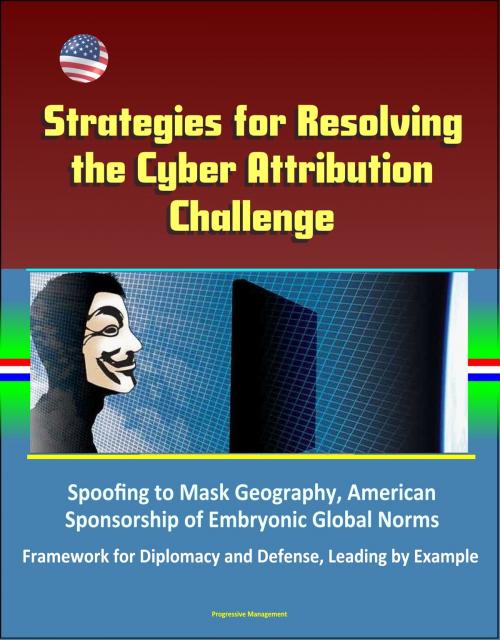Strategies for Resolving the Cyber Attribution Challenge: Spoofing to Mask Geography, American Sponsorship of Embryonic Global Norms, Framework for Diplomacy and Defense, Leading by Example
Nonfiction, Computers, Networking & Communications, Computer Security, Operating Systems, Application Software| Author: | Progressive Management | ISBN: | 9781370087068 |
| Publisher: | Progressive Management | Publication: | September 5, 2016 |
| Imprint: | Smashwords Edition | Language: | English |
| Author: | Progressive Management |
| ISBN: | 9781370087068 |
| Publisher: | Progressive Management |
| Publication: | September 5, 2016 |
| Imprint: | Smashwords Edition |
| Language: | English |
This excellent report has been professionally converted for accurate flowing-text e-book format reproduction. Malicious cyber actors exploit gaps in technology and international cybersecurity cooperation to launch multistage, multi-jurisdictional attacks. Rather than consider technical attribution the challenge, a more accurate argument would be that "solutions to preventing the attacks of most concern, multistage multi-jurisdictional ones, will require not only technical methods, but legal/policy solutions as well." Deep understanding of the social, cultural, economic, and political dynamics of the nation-states where cyber threat actors operate is currently lacking. This project aims to develop a qualitative framework to guide US policy responses to states that are either origin or transit countries of cyber attacks.
The current focus of attribution efforts within the national security context concentrates on law enforcement paradigms aiming to gather evidence to prosecute an individual attacker. This is usually dependent on technical means of attribution. In malicious cyber actions, spoofing or obfuscation of an identity most often occurs. It is not easy to know who conducts malicious cyber activity. But private sector reports have proven that it is possible to determine the geographic reference of threat actors to varying degrees.
Executive Summary * Chapter 1 - Introduction * Chapter 2 - The Cyber Environment * A Holistic View of Cyberspace * Multistage, Multijurisdictional Attacks * Spoofing Machines to Mask Geography * Chapter 3 - American Sponsorship of Embryonic Global Norms * American Sponsorship of Global Norms * The Anti-trafficking-in-Persons Initiative * The Global Culture of Cybersecurity and Embryonic Norms for State Responsibility in Cyberspace * The Global Cybersecurity Behavioral Baseline * The WSIS and Global Cybersecurity * Internationally Wrongful Acts in Cyberspace * Chapter 4 - A Framework for Development, Diplomacy, and Defense * Development, Diplomacy, and Defense Responses * A Need for Norms on Cyber Weapons * Language for "Victims of Trafficking in Malicious Code" Legislation * Leading by Example: US-based Entities' Responsibility * Chapter 5 - Conclusion * "Where Do We Go from Here? * Linking It All Together * Abbreviations
This excellent report has been professionally converted for accurate flowing-text e-book format reproduction. Malicious cyber actors exploit gaps in technology and international cybersecurity cooperation to launch multistage, multi-jurisdictional attacks. Rather than consider technical attribution the challenge, a more accurate argument would be that "solutions to preventing the attacks of most concern, multistage multi-jurisdictional ones, will require not only technical methods, but legal/policy solutions as well." Deep understanding of the social, cultural, economic, and political dynamics of the nation-states where cyber threat actors operate is currently lacking. This project aims to develop a qualitative framework to guide US policy responses to states that are either origin or transit countries of cyber attacks.
The current focus of attribution efforts within the national security context concentrates on law enforcement paradigms aiming to gather evidence to prosecute an individual attacker. This is usually dependent on technical means of attribution. In malicious cyber actions, spoofing or obfuscation of an identity most often occurs. It is not easy to know who conducts malicious cyber activity. But private sector reports have proven that it is possible to determine the geographic reference of threat actors to varying degrees.
Executive Summary * Chapter 1 - Introduction * Chapter 2 - The Cyber Environment * A Holistic View of Cyberspace * Multistage, Multijurisdictional Attacks * Spoofing Machines to Mask Geography * Chapter 3 - American Sponsorship of Embryonic Global Norms * American Sponsorship of Global Norms * The Anti-trafficking-in-Persons Initiative * The Global Culture of Cybersecurity and Embryonic Norms for State Responsibility in Cyberspace * The Global Cybersecurity Behavioral Baseline * The WSIS and Global Cybersecurity * Internationally Wrongful Acts in Cyberspace * Chapter 4 - A Framework for Development, Diplomacy, and Defense * Development, Diplomacy, and Defense Responses * A Need for Norms on Cyber Weapons * Language for "Victims of Trafficking in Malicious Code" Legislation * Leading by Example: US-based Entities' Responsibility * Chapter 5 - Conclusion * "Where Do We Go from Here? * Linking It All Together * Abbreviations















